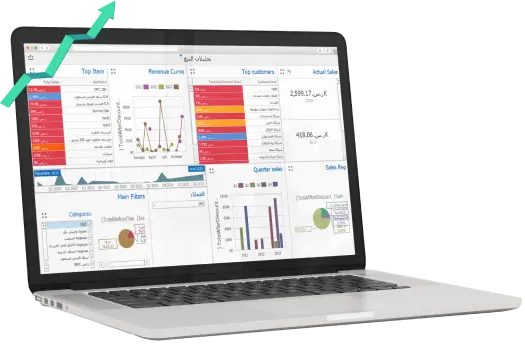At first, must be differentiate in the chart of accounts in liabilities between suppliers and creditors, meaning that the supplier is the person who supplies the materials that enter the company’s warehouse, but the service provider is the person who does the service of the company such as the medical insurance company or security& guarding companies or cleaning companies, electricity and water.
In Practical Reality, there are two types of service providers
Type I:
A service provider with no contracts
In other words, he supplies a monthly service in return for a monthly invoice like government suppliers such as electricity, water and gas, as well as any other supplier that is handled monthly
And he brings an invoice such as a guarding company for example or a cleaning company, and it is possible that handled by guarding and cleaning companies and so on can be done through annual contracts and the resulting liabilities and payment dates.
In this case, when the invoice is brought in every month, a monthly accrual of the expense is created
The journal entry is as follows:
|
Account |
Debit |
Credit |
|
Expense Account |
XXX |
|
|
Accounts Payable |
XXX |
And this journal entry is by the invoice date
Then accounts payable journal entry is created for the service provider
|
Account |
Debit |
Credit |
|
Accounts Payable |
XXX |
|
|
Bank/ Notes Payable |
XXX |
Of course, the expense will be according to its function, meaning that if the expense pertaining to department, it is an administrative expense, and if the expense pertaining to the factory, it is an operating expense, if the expense pertaining to selling fairs, it is a selling & marketing expense, and most of the invoices for service providers are after the end of the month and there are two points of view in accounting treatment
The first, which is the best in terms of practical reality
It is to open an account for each service provider separately in which the journal entry is recorded for each accounting transaction and the journal entry is of course by the invoice date indicating all the details and this makes it easy to follow the account of each service provider separately
The second method
It is an accrued expense (accrual)
In other words, that an account is not opened for each service provider, but rather it is dealt with on the accrued expense account, which is, for example, in the case of the electricity bill for the month of November, in this case an accrual is created on November 30
|
Account |
Debit |
Credit |
|
Electricity Expenses |
XXX |
|
|
Accrued Expenses (Electricity Expenses Payable) |
XXX |
When paying
|
Account |
Debit |
Credit |
|
Accrued Expenses |
XXX |
|
|
Cash/ Bank |
XXX |
The whole idea is that we have a general ledger account, which is it is an accrued expenses account for any expense pertaining to the current period, but it will be paid in a subsequent period, but there must be an analysis of the accrued expense account and an analysis of each item of accrued expenses separately at the end of the fiscal periods
And some people overcome this issue by opening a sub-ledger account for each accrued expense separately, meaning that there is a general ledger account, which an accrued expense account and let it be a code for example 110 and under it includes different accrued expenses accounts of such as
11010 Electricity Expenses Payable
11020 Water Expenses Payable
11020 Medical Insurance Expenses Payable
This is the case for each type of accrued expenses and that will be paid during the subsequent period the current period
Type II:
It is in the case that, if there is a contract with the service provider and the contract stating the dates of service in each month or according to the agreement, the contract value, the duration of the contract and the payment dates, and in most cases there will be one invoice by the total contract value and according to the accounting accrual principle, each month must be allocated by its proportion of the expenses
In principle, the contract value must be fully recorded in order to know the value of the accrued liability by the company after each payment you pay it to this service provider, and there are two accounting treatments used in practical reality
The first method
Example Al-Salam company contracted a medical insurance company with a value of 1200000 Egyptian pounds per year, advance payments of 200,000 were paid, and the rest is paid in two payments every 6 months
First, the value of the contract is 1200000 Egyptian pounds, and the contract period is 12 months, so the proportion of the month= 120000/12= 100000 Egyptian pounds
Second, the contract must be recorded as a liability by the company in the books and the journal entry is as follows
|
Account |
Debit |
Credit |
|
Other Receivables- Medical Insurance Contracts Receivable |
1200000 |
|
|
Current Liabilities- Medical Insurance Company |
1200000 |
This journal entry is recording of the value of the contract as an asset and a liability of the same value, but the basic idea is that the value of the contract appears in the trial balance as a liability by the company
And every month it is allocated by its proportion of the insurance value, which is one hundred thousand pounds per month (1200000/12)
|
Account |
Debit |
Credit |
|
Medical Insurance Expense |
1000000 |
|
|
Medical Insurance Contracts Receivable |
1000000 |
Thus, every month until the end of the contract period and this is of course according to the accrual principle and payment to the supplier according to the terms of the contract
In this example, there was an advance payment of 200000 Egyptian pounds, and the journal entry is as follows
|
Account |
Debit |
Credit |
|
Medical Insurance Company |
200000 |
|
|
Bank |
200000 |
At the end of June, the first payment is paid according to the contract, and the journal entry is as follows
|
Account |
Debit |
Credit |
|
Medical Insurance Company |
500000 |
|
|
Bank |
500000 |
At the end of December, the second payment is paid according to the contract, and the journal entry is as follows
|
Account |
Debit |
Credit |
|
Medical Insurance Company |
500000 |
|
|
Bank |
500000 |
The second accounting treatment
First, recording the contract value fully
|
Account |
Debit |
Credit |
|
Prepaid Expenses (by Contract Value Fully) |
1200000 |
|
|
Medical Insurance Company |
1200000 |
This accounting treatment is used in practical reality, but some disagree that recording of prepaid expenses by the contract value fully even though it was paid only in advance is
200000 Egyptian pounds, the basic idea is that an asset and a liability have been recorded at the same value (journal entry the contract’s recording) and the prepaid expense (a current asset) is not a condition that it is paid fully, the idea is to record the contract’s value and show the full value of the liability and then reduce the prepaid expense in advance monthly until the end of the contract by the following journal entry
|
Account |
Debit |
Credit |
|
Medical Insurance Expense |
100000 |
|
|
Prepaid Expenses- Prepaid Insurance |
100000 |
The payment to the supplier (Prepaid Expenses) journal entry
|
Account |
Debit |
Credit |
|
Medical Insurance Company |
200000 |
|
|
Bank |
200000 |
According to the example, every 6 months, a payment is paid to the suppliers, which are 500000 at the end of June, the first payment is paid according to the contract, and the journal entry is as follows
|
Account |
Debit |
Credit |
|
Medical Insurance Company |
500000 |
|
|
Bank |
500000 |
At the end of December, the second payment is paid according to the contract, and the journal entry is as follows
|
Account |
Debit |
Credit |
|
Medical Insurance Company |
500000 |
|
|
Bank |
500000 |
There is another accounting treatment used by some, but it requires the finance department to follow the liabilities of all contracts, follow them on an external sheet Excel, and recording a monthly accrual, we must pay attention and review accurately and periodically, and journal entry is at the end of each month until the end of the contract period as follows
|
Account |
Debit |
Credit |
|
Medical Insurance Expense |
100000 |
|
|
Medical Insurance Company |
100000 |
Upon payment to the supplier, according to the terms of the contract, the amount of the payment installments and its dates, the payment journal entry is as follows
Let it be, for example, according to the example, advance payment amount 200000
|
Account |
Debit |
Credit |
|
Accounts Payable |
200000 |
|
|
Bank |
200000 |
According to the example, every 6 months a payment is paid to the supplier, which is 500000, and at the end of June, the first payment is paid according to the contract, and the journal entry is as follows
|
Account |
Debit |
Credit |
|
Medical Insurance Company |
50000 |
|
|
Bank |
50000 |
At the end of December, the second payment is paid according to the contract, and the journal entry is as follows
|
Account |
Debit |
Credit |
|
Medical Insurance Company |
500000 |
|
|
Bank |
500000 |
Service Providers Accounts are important matters and are largely present in practical reality; the accounts payable accountant must be aware with the accounting treatment method
Checks at service providers accounts
It is a payment order issued by a party and it is the drawer (the owner of a bank account in this bank) to a second party and it is the bank to pay a specific amount to a third party who is the beneficiary and either that the payment of the check be on a specific date or either at any other time or either that the beneficiary is paid only or that it be endorsed to another beneficiary to payment it, or that it is cashed, or that the value of the check is deposited in the beneficiary’s account and all these types according to the nature of the check, and therefore the check consists of three parties and the check contains a set of basic data that must be available in any check such as the name of the bank, branch, check due date, name of account holder and account number, the person who will write the check to the beneficiary and sign the person who holds the account, the name of the beneficiary of the check and the amount of the check in numbers and letters.
Open Cheque: is the check that can be paid at any time regardless of the date written on the check and it can be paid immediately to any person who submits it to the bank except in the case that the bank was informed of stopping the check payment and has all the previous data and it is uncrossed
A/C Payee Only: it is a check like the open cheque, but it is added to it (it is paid for the first beneficiary only) and this prevents the endorsement of the check to another beneficiary to pay it and there was previously in the check a word (for an order) and it is canceled when the company wants that the check is paid to the first beneficiary only, but the word was canceled in the new checks.
Crossed Check: is the same as the open cheque data, but it is underlined by two parallel lines, and this type of check is used in practical reality a lot and one of its advantages is that it can only be paid on its due date in addition to that it is not cashed but it is deposited in the beneficiary’s account only and therefore can only be paid the beneficiary has a bank account.
Bank Check: is a check that is prepared based on the letter of the bank’s issuer by issuing a bank check in favor of the beneficiary with the required amount, the bank issues the check from the bank's checkbooks to deduct the value from the company's account and at any time the beneficiary submits the check to the bank, the amount is reserved for him.
Certified Check: this check is used in government agencies, customs and social insurance, which require either payment by certified check because the open cheque can be rejected by the bank because the balance of the certified check, it is done from the company’s checkbook for the beneficiary by the amount, and then a letter addressed from the company to the bank requesting that the bank approves the certified check for the beneficiary and the bank reserves the value of the check from the company’s accounts and stamps the check with certified check stamp and this is its meaning and when the beneficiary presents this the check for the bank will find the value of the check reserved for him from the company's accounts.
Checks Clearing: the idea of checks clearing in a nutshell is that for example, there is a customer at National Bank of Egypt and with him a checkbook for National Bank of Egypt and he purchases goods from the supplier and the supplier gave him a check to National Bank of Egypt of 100000 for example, but this supplier does not have an account in the National Bank of Egypt and his account in ALEXBANK, the supplier deposits the check in ALEXBANK, ALEXBANK representative takes the check to the clearing house and hands it over to National Bank of Egypt representative, Likewise, National Bank of Egypt representative delivers the checks that he has concerning ALEXBANK to the ALEXBANK representative, thus, the banks do the checks clearing
In the absence of a balance in the account of the buyer, National Bank of Egypt customer, National Bank of Egypt representative stamps the check on the back that the balance is insufficient with the (clearing) stamp, meaning that the check has become with the first beneficiary, the ALEXBANK customer, until the settlement with of National Bank of Egypt customer
Meaning that each bank has a room in the central bank called the clearing house, and an employee from each bank is appointed to do this task, the bank representative is at the clearing house
In this clearing house, all banks representatives meet and there checks are exchanged.
Bill of Exchange: it is an instrument written in a particular way according to the law of each country that is an order from a party and it is the creditor (the drawer) to a party (the debtor) called the drawee, who has to pay a specific amount upon review or on a specific date for the permission of a third party that can the same drawer or to a third party is called the beneficiary, and each country specifies the bill of exchange data, it must contain the word bill of exchange, in the instrument, the name of the party who has to pay (drawee), the due date, the place of payment and the date and place of issuing the bill of exchange and the signature of the party who created it and the bill of exchange it has three parties: the drawer, the drawee, and the beneficiary.
Promissory Note
A promissory note is an instrument written in a particular way in accordance to the law of the country and it is a promise by the debtor to the creditor to pay a specific amount on a specific date, therefore, the promissory note has only two parties, the first is the debtor undertaking to pay and the second party is the beneficiary which is written the note for him, and it has all the same all data on the bill of exchange.










